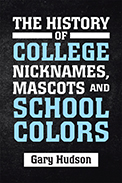
 |
A collection of the history behind the identifying features of college football teams, the text is a goldmine for sports trivia enthusiasts, both casual and those who regularly compete at pub trivia nights. Even the most ardent fans will likely learn something new about the teams they root for. Hudson’s objective in creating an aggregate resource that disseminates information about school sports is portrayed clearly in a simple but direct structure that features the school’s name, nickname, mascot, colors, conference, and typically several paragraphs delving into its history and fun facts. In other words, audiences won’t have to hunt long to get the information that they’re looking for.
Perhaps the most alluring element of a work like this is its inclusion of history and tradition. Whether it is Boise State University’s school mascot and colors being founded in 1932 or Iowa State’s Cyclones in 1885, many schools have customs and rituals associated with their nicknames that stretch back for decades or even centuries. Other major schools like Miami University changed their nickname to distinguish themselves from Denison University, also located in Ohio.
Iconic college nicknames like “Cornhuskers,” “Golden Bears,” “Bruins,” and “Beavers” are all representative of their locales, states, and their respective histories. Intriguingly, numerous nicknames evolved or were changed as a result of rising awareness of social norms. Most prominently, the famous Stanford Cardinal was formerly known as the Stanford Indian before the name was dropped out of respect for Native Americans. Audiences who seek to learn more about their college football sports teams will not need to go beyond this book for a complete and comprehensive resource.